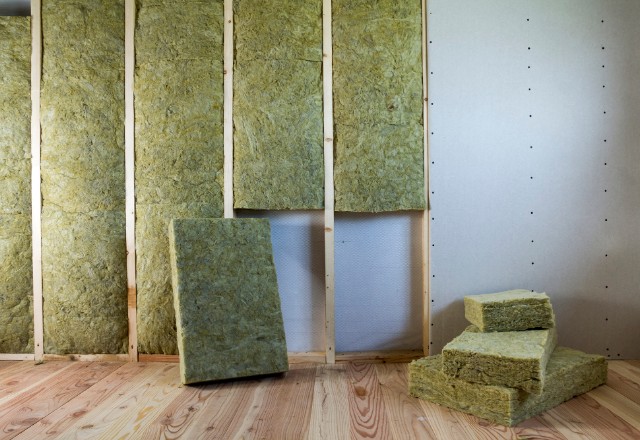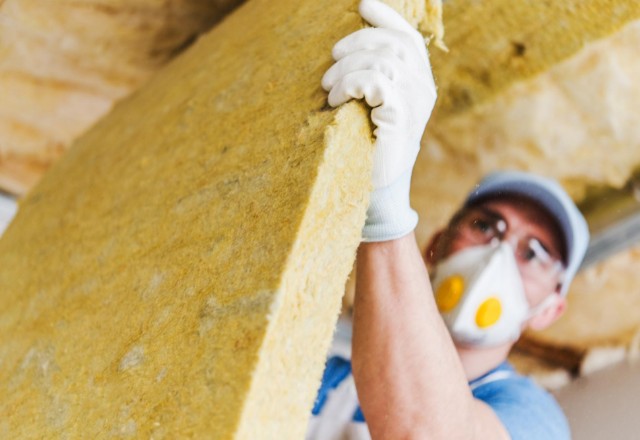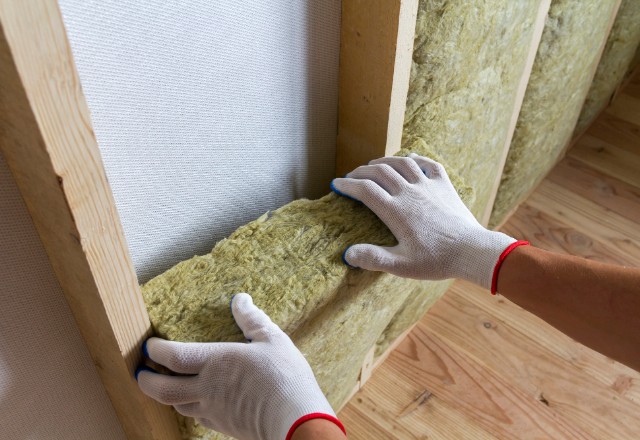Understanding Rockwool
Rockwool refers to a type of insulation material made from basalt rock and recycled slag. The rock gets melted and spun into fibrous material resembling wool, hence the name “rock wool”.
The fine yet durable fibers entrap air pockets, which provide excellent insulating qualities. Rockwool demonstrates similar thermally resistive properties as traditional fiberglass insulation. However, it offers certain enhanced performance benefits.
The dense structure makes rockwool insulation an effective acoustic dampener as well. It helps block exterior noise from entering interior living spaces. Besides insulation and soundproofing, rockwool finds extensive use for fire resistance applications thanks to its high melting point.
Overall, understanding what rockwool comprises of and how its fabrication process creates millions of tiny trapped air pockets is key. The resulting product demonstrates unique physical traits ideal for insulating against different elements – cold, heat, sound, and fire.
Need a roofing contractor to install or replace rockwool attic insulation?
Call us (509)201-4190 or send the form
Rockwool Insulation Benefits
Energy Efficiency
Rockwool delivers exceptional thermal performance thanks to millions of tiny air pockets trapped within the dense fiber structure. These pockets create substantial resistance to heat flow, dramatically reducing heat loss in winter and heat gains in summer. Attic insulation thickness directly enhances efficiency. With an R-value of 3.6 per inch, rockwool exceeds fiberglass. For cold climates, recommend R-38 to R-60 rockwool. This high resistivity cuts HVAC costs and improves comfort.
Fire Safety
Rockwool can withstand temperatures up to 2100°F before melting. Unlike plastic foams, it does not emit toxic fumes in fire. Rockwool attic insulation forms a barrier inhibiting flame spread. Having non-combustible rockwool lining improves fire safety and reduces structural damage risk if electrical shorts or lightning strikes spark attic fires. Consider adding special fire-rated rockwool products around chimneys and heating appliances for enhanced protection.
Soundproofing
In addition to thermal insulation, rockwool efficiently absorbs sound. Its dense structure and friction dampen noise vibrations rather than reflecting them like synthetics. Strategically placing attic rockwool batts and loose-fill across noise ingress areas can dramatically cut exterior noise pollution transfer into living zones. Acoustic testing shows rockwool blocking over 50% more outside noise than traditional insulations.
R-Value
The R-value or thermal resistivity indicates effectiveness in stopping heat flow. The higher the R-value, the better the performance. Rockwool has an R-value of 3.6 per inch. Thus R-15 rockwool equates to a 4” thickness. For cold northern climates prone to heat loss, use R-38 to R-60 grades to save energy. Compare insulating values when selecting insulation to suit your climate and budget.
Durability
Rockwool fibers resist compression and retain insulating performance for decades without sagging or shrinking like other insulations. The material’s dimensional stability ensures consistent thermal protection over time. Rockwool keeps saving money for longer vs low durability alternatives requiring frequent replacement. Its water repellent properties also prevent heat-sapping moisture damage.
Sustainable Choice
Made from abundant natural stones and recycled content, rockwool represents an sustainable green insulation option. Production uses minimal energy with no chemical binders. Compare this to plastic foam manufacture. Unlike fiberglass which can shed microfibers, rockwool avoids airborne pollution. Cleaner production and recyclability make rockwool a responsible eco-friendly choice.

How Effective is Rockwool for Attic Insulation
Enhancing Comfort
Effective attic rockwool installation enhances home comfort in multiple ways:
Temperature Moderation
High R-value rockwool batts or loose-fill added to attic floors or rafters creates substantial thermal resistance. This insulation ability keeps attics cooler in summer and warmer in winter. Heat and cold get trapped in the attic instead of transferring into living zones.
Draft Prevention
Tiny air pockets within dense rockwool fibers block convective flows of heat transfers through gaps. Eliminating leaks prevents cold drafts in winter. No more shivering beside walls or around electrical outlets.
Noise Reduction
Rockwool excels at sound dampening thanks to its high-density structure. Adding insulation over ceilings and walls adjoining attics helps block outside noise like traffic from disturbing indoor relaxation.
Moisture Control
Rockwool resists moisture intrusion far better than paper-faced insulations. Preventing water retention helps ensure good indoor air quality without mold risks.
Overall, rockwool attic insulation enhances comfort through better temperature moderation, draft control, sound absorption and moisture resistance.

Improving Home Value
Upgrading attics with R-38 or higher rockwool insulation adds value by increasing buyer appeal while saving money long-term:
Curb Appeal
Better insulated attics require smaller, less costly HVAC systems. This saves buyers equipment CapEx expenses. Lower energy bills also facilitate home sales.
Bigger Budget
With rockwool delivering over 50% heating/cooling savings in some climates, homeowners gain extra disposable income boosting affordability.
Appraisal Value
Rockwool attic insulation enhances property value appraisals via rising sustainability standards. Green building certification programs recognize enhanced insulation.
In summary, prospective homeowners get more interested in well-insulated houses. Beyond comfort and savings, rockwool insulation unlocks financial incentives to improve market valuations.

Rockwool Attic Insulation – Step-by-Step DIY Installation Guide
Preparation
Tools:
- Tape measure
- Utility knife
- Staple gun
- Hammer
- Fasteners (nails, screws)
- Extension cord, portable light
PPE:
- N95 dust mask
- Protective gloves and goggles
Safety Measures:
- Inspect attic for wiring, equipment and hazards
- Ensure adequate lighting for safe navigation
Air Sealing:
- Seal all attic cracks, gaps and openings using caulk or spray foam
Vapor Barrier Importance:
- Install vapor barrier facing (foil, kraft paper) under insulation to prevent moisture-related performance damage

10 Key Installation Steps
- Measure attic area and determine required insulation R-value as per climate zone to calculate amount needed.
- Mark framing locations for mounting vapor barrier support layers.
- Staple or nail reflective insulation vapor barrier layer across entire surface area with sealed seams.
- Add a secondary wind-proof membrane layer over primary vapor barrier for further infiltration protection.
- Mark out installation zones per size of insulation batts to be placed in each section.
- Trim batt segments to fit snugly and completely fill spaces between trusses or rafters when placed.
- Use loose-fill rockwool to insulate irregular areas around ductwork, wiring etc.
- Glue/staple external facing at insulation joints to minimize thermal gaps or wind penetration.
- Attach “Installation Date & Insulation Type” marker signs on entry points to attic access.
- Periodically check attic insulation integrity and supplement settled sections.

Comparing Attic Insulation Types
When selecting attic insulation, key factors to compare include thermal performance, cost, environmental impact, and ease of installation. Below is an overview of common insulation materials and how they compare on essential criteria:
Insulation Type | Thermal Properties | Indicative Installed Cost | Eco-Profile | Install Difficulty |
Fiberglass Batt | R-value: ~3 per inch | Lower ($0.8-1 per sq.ft) | Moderate Eco Impact | Easy: Staple Between Framing |
Cellulose Loose-fill | R-value: 3.5-3.7 per inch | Low ($1-1.3 per sq.ft) | Excellent Sustainability | Messy: Blown Application |
EPS Rigid Foam | R-value: 4 per inch | Higher ($1.5-2 per sq.ft) | Poorest: Lots of VOC Emissions | Complex: Board Cutting & Fitting |
Rockwool Batts | R-value: 3.6 per inch | Mid-Range ($1.25 per sq.ft) | Very Good: Natural & Recycled Content | Easy: Friction-Fit Install |
Key Takeaways:
- Fiberglass is cheapest but lacks durability vs rockwool over long term
- Cellulose has higher thermal performance but loose-fill application is messy
- Rigid foam boards have best R-value but high environmental impact
- Rockwool provides easiest installation with recycled and high sustainability merits

Environmental Impact
Sustainability
Rockwool insulation offers significant sustainability advantages:
- Contains up to 70% recycled content from waste streams like metal production slag, reducing landfill disposal
- Spinning manufacturing process uses minimal energy and zero chemical binders
- Environmentally superior to plastic foam insulations with high carbon footprint
- End-of-life products can be reused or recycled instead of landfilling
- Made from abundantly available basalt rock instead of scarce resources
These merits make rockwool a greener insulation choice meeting rising eco-standards worldwide. Homeowners concerned about environmental impacts should strongly consider rockwool.
Health Safety
Regarding health and safety:
- Rockwool fibers higher density limits particulate release risk
- No toxic offgassing or formaldehyde emissions associated with plastic foams
- With dust masks, fiber exposure during handling and installation is minimized
- EU quality certifications confirm non-carcinogenic material composition
- No documented links between properly installed rockwool exposure and respiratory issues
Proper precautions include using facial protection, adequate site ventilation and mechanized cutting tools instead of manual sawing to limit fine particulate inhalation.
The American Lung Association and NAIMA industry body state rockwool material safety when following recommended work practices for insulation application. Always confirm safety handling directions before commencing installation projects.
In summary, rockwool represents a sound health and safety profile overall given non-toxic, quality controlled material composition and available protective measures during installation.

Conclusion
Installing rockwool insulation in attics delivers immense home efficiency and comfort benefits thanks to the material’s outstanding thermal, acoustic and fire resistive properties. Its high R-value per inch surpasses conventional insulations like fiberglass.
Strategic placement between roof rafters, over ceiling joists and across hard-to-fill spaces ensures comprehensive temperature, sound and fire control. Tightly fitting rockwool batts or blown-in loose-fill minimizes energy leaking gaps.
Compared to foam boards or cellulose options, rockwool combines easiest DIY installation with superior insulation durability meaning maintained long-term savings. Vapour barrier integration is vital to prevent moisture-related performance reductions.
Application best practices like safety gear use, air sealing, calculated coverage and signage prevent issues. Compared to other insulations, rockwool also shines for sustainability merits like recycled content, low emissions and recyclability.
Given extreme attic conditions, choosing the right insulation is key to energy savings. Rockwool roof spaces application helps cut electricity bills by over 50% while making homes comfortable, quieter and safer. This future-proof investment protects budgets and the planet.



 509-201-4190
509-201-4190
